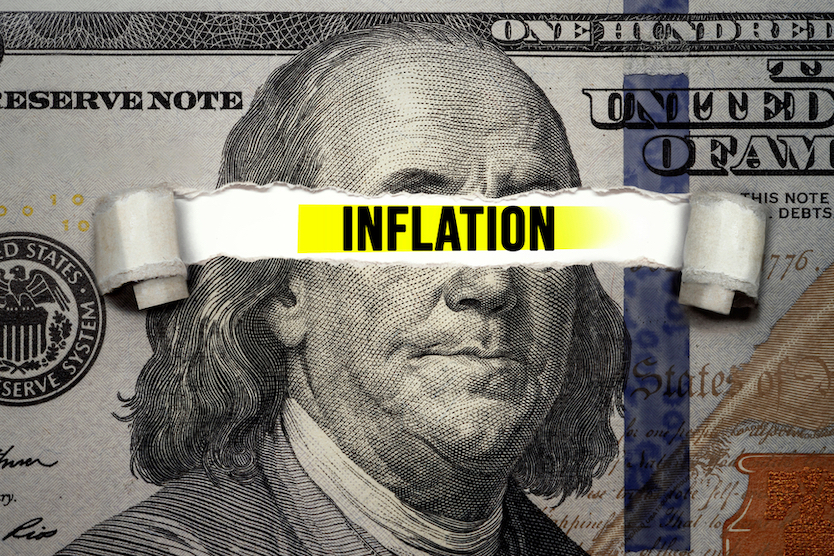
Over the past few weeks, you might have noticed headlines warning about impending inflation.
Inflation, as measured by the Consumer Price Index (CPI), rose 0.6% in March and 0.8% in April, according to the Bureau of Labor Statistics. For some, the alarm bells started ringing. If inflation stayed at this rate, we could be looking at anywhere from 7-10% inflation for 2021. That would be enough to erode virtually anyone’s portfolio gains — or at least take out a decent chunk.
However, that’s unlikely to happen. In fact, the current increases are in line with most economists’ expectations, especially if you’re only looking at inflation through the lens of the CPI. The CPI is calculated using a year-over-year analysis. When you compare April 2021 — when the U.S. is mostly vaccinated and riding high on all-time-high stock market returns and housing prices — to April 2020 — when the U.S. was being ravaged by a once-in-a-century global pandemic with no end in sight — inflation is going to look worse than it really is.
In reality, though, inflation is only slightly above average. As you’ll see later, for some investors, that’s a good thing.
There’s another metric for inflation called the PCE, or personal consumption expenditure, and if you include it as a gauge for overall inflation, the numbers start to look much tamer. It’s a common inflation metric for goods and services. In March of 2021, the Federal Open Market Committee predicted that PCE will average 2.4% in 2021. That’s about on par with its historical average.
Still, while current inflation might not be quite as high as the media is making it out to be, keep in mind that in the past 100 years, the U.S. has experienced 20 years of 7%+ inflation. The main factors driving inflation are overall money supply and economic growth. In order to fuel the stimulus, the Fed has been printing quite a bit of money. That, alongside economic growth, will cause businesses to raise prices. The question is whether or not those increases will be equal to or far above the historical average.
Looking at history as a prediction for the future, though, there’s a solid chance that at some point in our lifetimes, we’ll see high inflation. So how can you, as a savvy investor, prepare for it?
How to Hedge Against Inflation: Invest in “Hard Assets”
What is a hard asset and how does it differ from any other asset?
A hard asset holds intrinsic value, and it’s typically tangible (“hard”). Its availability is scarce, and it tends to serve a basic human need. Even in the worst of times, you can use hard assets to barter or trade. As such, hard assets hedge against inflation. Some examples include:
- Real Estate (both land and the properties built upon the land)
- Vehicles
- Office Furniture
- Machinery
- Raw Materials (gold, oil, copper, aluminum)
On the other hand, soft assets don’t hold intrinsic value and they aren’t tangible. If inflation increases, so do the price of these assets. Some examples include:
- Stocks and bonds
- Intellectual property
- Brand recognition
- Paper money
How Does Real Estate Hedge Against Inflation?
As we reviewed above, real estate is a “hard” asset. It hedges against inflation because it has intrinsic value, a limited supply, and it serves a basic human need.
Imagine, for instance, that because of inflation, the purchasing power of a dollar goes down by 20% in the next ten years (which is about on par with average inflation). You can expect, then, if you’ve been maintaining your investment property or single-family residence, for your house value to be at least 20% higher than it was ten years ago — and that’s assuming no increase in the demands for housing in your area.
No matter what happens with the stock market or the economy generally, you still own a deed. If it all falls apart, you still have ownership over a piece of land and the property that is built on the land.
Furthermore, if the dollar stopped existing entirely due to hyperinflation or poor fiscal policy, people would use hard assets as a way to transfer value. Commodities like gold and silver would be used to split up larger purchases like vehicles and real estate. You wouldn’t accept any amount of money for your home in the event that your country’s currency became worthless, but you would probably consider bartering your home for the right amount of gold or luxury vehicles.
Real estate hedges against inflation for those reasons.
Conclusion
According to the BLS, inflation rose 0.6% in March and 0.8% in April. This looks worse than it is because, in order to calculate CPI — one of the metrics most government organizations use to measure inflation — you have to perform a year-over-year analysis, comparing this March to last March and this April to last April (and so on). That makes the numbers look worse than they are.
Still, the US has gone through periods of pretty high inflation in the past 100 years. If we use history as a barometer for the future, we can expect to see high inflation at some point in our lifetimes.
If you’re an investor, that means you should have your portfolio exposed to different assets, both “soft” (stocks and bonds) and “hard” (real estate).
Hard assets, like real estate, hedge against inflation. They have a limited supply and serve a basic human need. If the dollar ceases to exist, people will use them as a way to barter.
